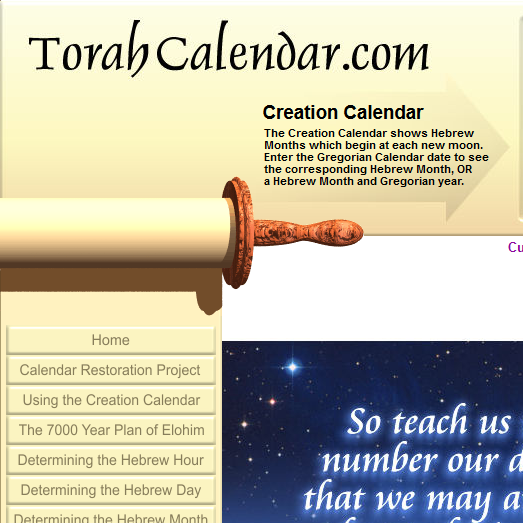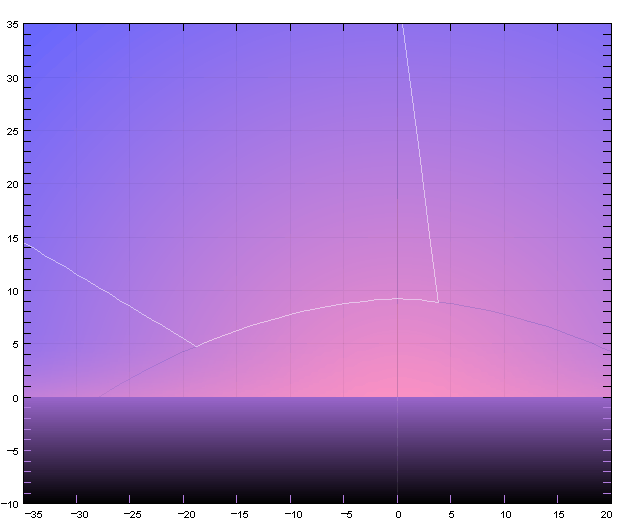Understanding the Sunset Diagram
The diagram above depicts a view of the western sky as seen from the proximity of the
Temple Mount in Jerusalem, observed at the moment of sunset, at or near the beginning of a Hebrew Month.
Select one of three buttons for viewing the new moon in Jerusalem on either the
Day Before, the New Moon Day or the Day After the new moon.
Then press
the View button.
The darker area at the bottom of the diagram represents a view of the horizon as
seen from the observer's location looking toward the west.
The yellow circle shows the sun's position just below the horizon at the moment of sunset.
The moon is shown as a thin crescent if it is visible. Otherwise,
if the moon's center lies on or below the curved part of the white visibility line,
it is represented as a white circle. A white circle indicates that the moon's
crescent is too faint to be seen with the naked eye due to the overwhelming effect
of the evening twilight when the moon is too low in topocentric altitude.
When the crescent moon is located close to the curved white visibility line, it is
shown inside a set of cross hairs. In cases like this, the new moon will be barely
visible and sighting it will require a perfectly clear sky.
The numbers across the bottom represent the difference in topocentric azimuth (DAZ)
between the moon and the sun in degrees. Topocentric azimuth is the angle measured
clockwise from true north where due west is 270°. This diagram is not fixed
to a particular azimuth. The point on the western horizon where the sun sets is
northward in the summer months and more southward during the winter. However, in this
diagram, the sunset is framed so that the sun's position is always shown at the
same place in the diagram.
The actual topocentric azimuth for both the moon and the sun are shown in the
tables below. The numbers along the left side of the diagram above show the topocentric
altitude angle of the moon (or sun) measured in degrees from the horizon.
If the moon is visible from Jerusalem, it will always lie within the two straight white
lines shown in the diagram. The moon never ventures outside of these boundaries
because the inclination of the plane of the moon's orbit never exceeds 5.145°
with the plane of the earth's mean orbit around the sun known as
the ecliptic.
Hebrew Months are numbered consecutively from 1 to 12 in a regular year, or from 1 to 13
in a leap year. The sequence of numbering Hebrew Months in the Creation Calendar is
consistent and never changes. Hebrew Month 1 is always at the beginning of a Spiritual
Year and occurs at the same time as Hebrew Month 1 in the Civil Year. In this way
there will never be confusion about how to keep the appointed times and festivals.
Hebrew Months are consistently numbered in an unchanging sequence in the Scriptures.
The Hebrew Months Named in Scripture
In the Hebrew Scriptures written prior to the Babylonian
exile, four months are labeled with Canaanite names.
The term Aviv describes the agricultural conditions that existed in
the month when the Exodus occurred which is equivalent to Month 1.
Aviv is a word meaning ripening barley and the month of
Aviv is the month of ripening barley
(Exodus 13:4,
23:15,
34:18,
Deuteronomy 16:1).
Ziv was a name for Month 2 which is related to the noun zayit, an olive tree.
The blossoming of the olive tree was a sign that winter was over and spring had arrived.
(1 Kings 6:1,
6:37).
Ethanim was a name for Month 7
which corresponds to the adjective
etan,
meaning perennial or ever-flowing, from the word
yatan,
to flow continuously.
(1 Kings 8:2).
Bul was a name for Month 8 from the noun bul, produce, from the verb yabal,
to bring forth
(1 Kings 6:38).
In the Hebrew Scriptures written during or after the Babylonian
exile, five months appear with Babylonian names. Nisan
was a name for Month 1
(Nehemiah 2:1,
Esther 3:7).
Sivan was a name for Month 3
(Esther 8:9).
Elul was a name for Month 6
(Nehemiah 6:15).
Kislev was a name for Month 9
(Nehemiah 1:1-2,
Zechariah 7:1-3).
Adar was a name for Month 12
(Ezra 6:15,
Esther 3:7,
3:13,
8:11-12,
9:1,
9:15,
9:17,
9:19,
9:20-22).
Ezekiel never referred to Hebrew Months with the names of pagan dieties, although he mentions
Tammuz once in
Ezekiel 8:14.
Tammuz is the pagan Babylonian name for Month 4.
It is of great interest to note that the believers who followed
יהושע
the Messiah never used pagan names to describe Hebrew Months. They were well
taught by the Master and simply numbered the Hebrew Months as Adam and Noah
did from the beginning.
One goal of the Creation Calendar Restoration Project would be to promote the restoration
of a pure nomenclature for numbering Hebrew Months and Hebrew Days of the week.
The Ancient Paths
The moon is a faithful witness in heaven that
יהוה
has firmly established throughout the ages by His word.

Psalms 89:34-37 I will not violate My covenant, nor alter the word that has
gone out of My lips. Once I have sworn by My set-apart-ness, I will not lie to
David: His seed shall endure throughout the ages, and his throne as the sun before
Me. It shall be established throughout the ages like the moon, like the faithful
witness in the sky. Selah.
This truth contradicts those who teach that the moon was on a constant cycle of 30 day
months, and that a year contained 360 days before the flood. The way in
which the Creator reckons time is ultimately demonstrated by the chronology encoded in
the history and future prophecy of Scripture.
יהוה
instructed Israel to follow the ancient paths or the Creation Calendar.

Jeremiah 6:16 Thus says
יהוה
, "Stand in the way and see and ask for the
ancient paths, where the good way is, and walk in it, and you shall find
rest for your souls."
The good way is also the narrow and precise
way spoken of by
יהושע
the Messiah.

Matthew 7:13-14 Enter by the narrow gate; for wide is the gate and broad is
the way that leads to destruction, and there are many who go in by it. But narrow
is the gate and difficult is the way which leads to life, and only a few find it.
Although the Hebrew Hour and the Hebrew Day can be observed from any location on
earth, the Hebrew Month and the Hebrew Year must be calculated from near the Temple Mount
in Jerusalem. In Hebraic thought, the foundation stone of the Temple of Elohim is considered the origin of the
physical universe. It was in the vicinity of the Temple Mount that
יהוה
made covenants with Abraham and King David, Solomon built the First Temple, Zerubbabel
built the Second Temple, and
יהושע
the Messiah renewed the covenant with mankind in
His own blood. It is for these reasons that the location of the Temple Mount in Jerusalem is so
intrinsically important.
It is first crescent visibility from Jerusalem which is the Scriptural reference
standard for time keeping. As Elohim created the lights in heaven for signs, appointed
times, days and years
(Genesis 1:14),
they truthfully tell what time it is. The
Scriptures indicate that the Torah of Elohim is truth
(Psalms 119:142).
They also indicate that the Torah goes forth from Jerusalem.

Isaiah 2:3 And many people shall go and say, Come and let us go up to the
mountain of
יהוה
, to the house of the Elohim of Jacob; and He will teach us of His ways,
and we will walk in His paths: for the Torah will go forth from Zion, and the word
of
יהוה
from Jerusalem.
For this reason, no one should forget Jerusalem when it comes to sighting the new moon.

Psalms 137:5-6 If I forget you, O Jerusalem, Let my right hand forget its skill!
If I do not remember you, Let my tongue cling to the roof of my mouth
-
If I do not exalt Jerusalem above my chief joy.
In the Age of Life, Jerusalem will be called the City of Truth.

Zechariah 8:3 This is what
יהוה
says: "I will return to Zion and dwell in
Jerusalem. Then Jerusalem will be called the City of Truth, and the mountain of
יהוה
Almighty will be called the Set Apart Mountain."
The new moon and the Sabbath figure prominently in the Age of Life.

Isaiah 66:22-24 "As the new heavens and the new earth that I make will endure
before Me," declares
יהוה
, "So will your name and descendants endure. From one
new moon to another and from one Sabbath to another, all mankind will
come and bow down before Me," says
יהוה
.
Reckoning the renewed first visible crescent moon from Jerusalem is a highly spiritual
act, as it directly connects a person with heaven, and thereby with one's Creator. The
heavenly bodies are out of the domain of mankind to control. When a person reckons the
beginning of a month by sighting the first visible crescent moon from
Jerusalem, that person comes into alignment with the Creator of the universe.
There is not a court on earth that will successfully reject the witness of heaven.
The cycles of the moon are one way the Creator communicates with His people. There are
many man-made religious systems that operate on calendars that do not take the cycles
of the moon into account. However, the heavens will always declare the brilliant majesty
of
יהוה
who is the Creator of the universe.

Psalms 19:1-6 The heavens declare the brilliant majesty of Elohim and the
firmament shows His handywork. Day after day they constantly pour forth speech, and
night after night they display intelligence. There is no speech or language where their
voice is not heard. Their line is gone out through all the earth and their words to the
end of the world. In them He has set a tabernacle for the sun which is as a Bridegroom
coming out of His chamber, as a champion rejoices to run a race. It rises at one end of
heaven and makes its circuit to the other: nothing is hidden from its heat.

Psalms 97:6 The heavens declare His righteousness, and all the people
see His brilliant majesty.

















